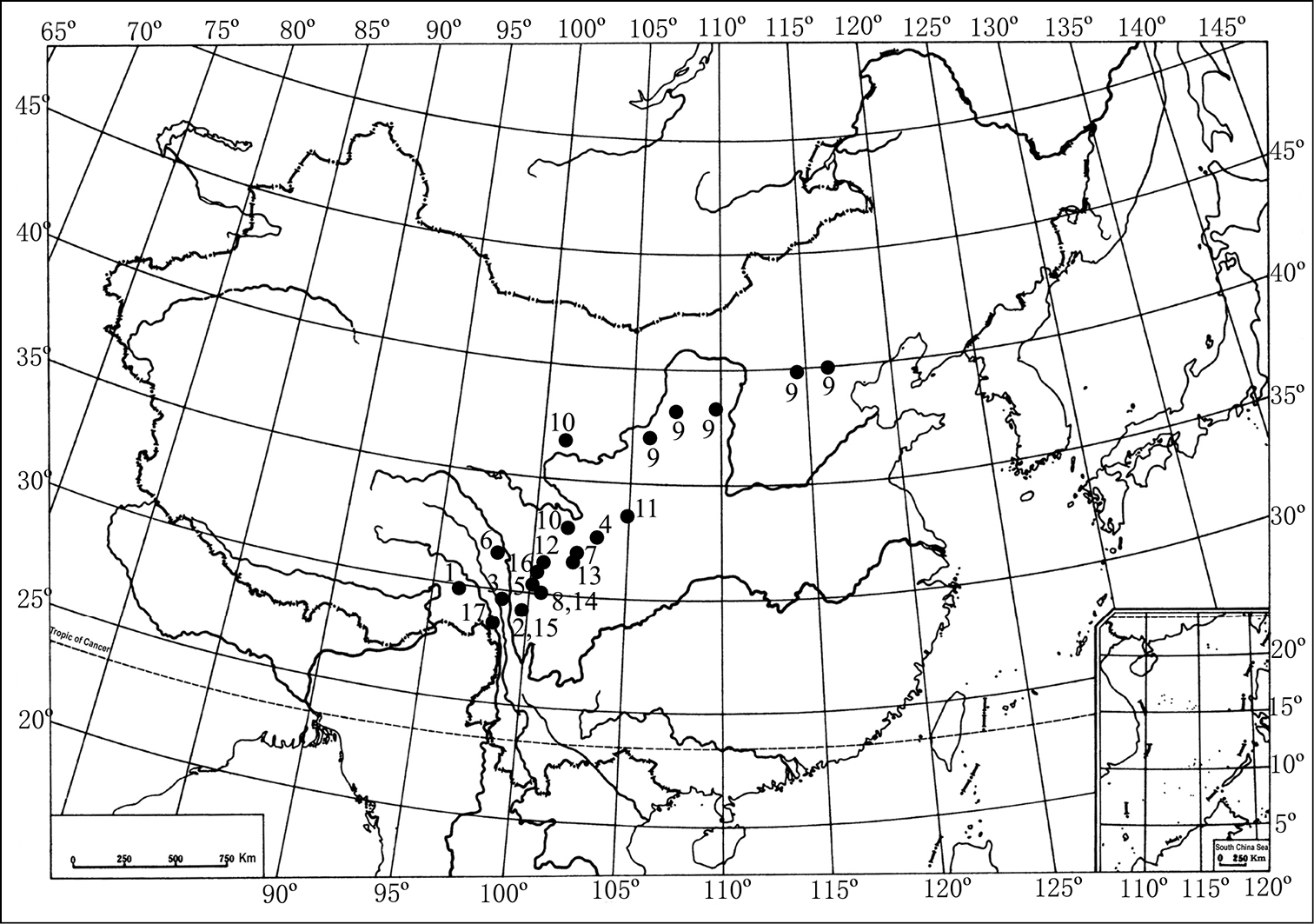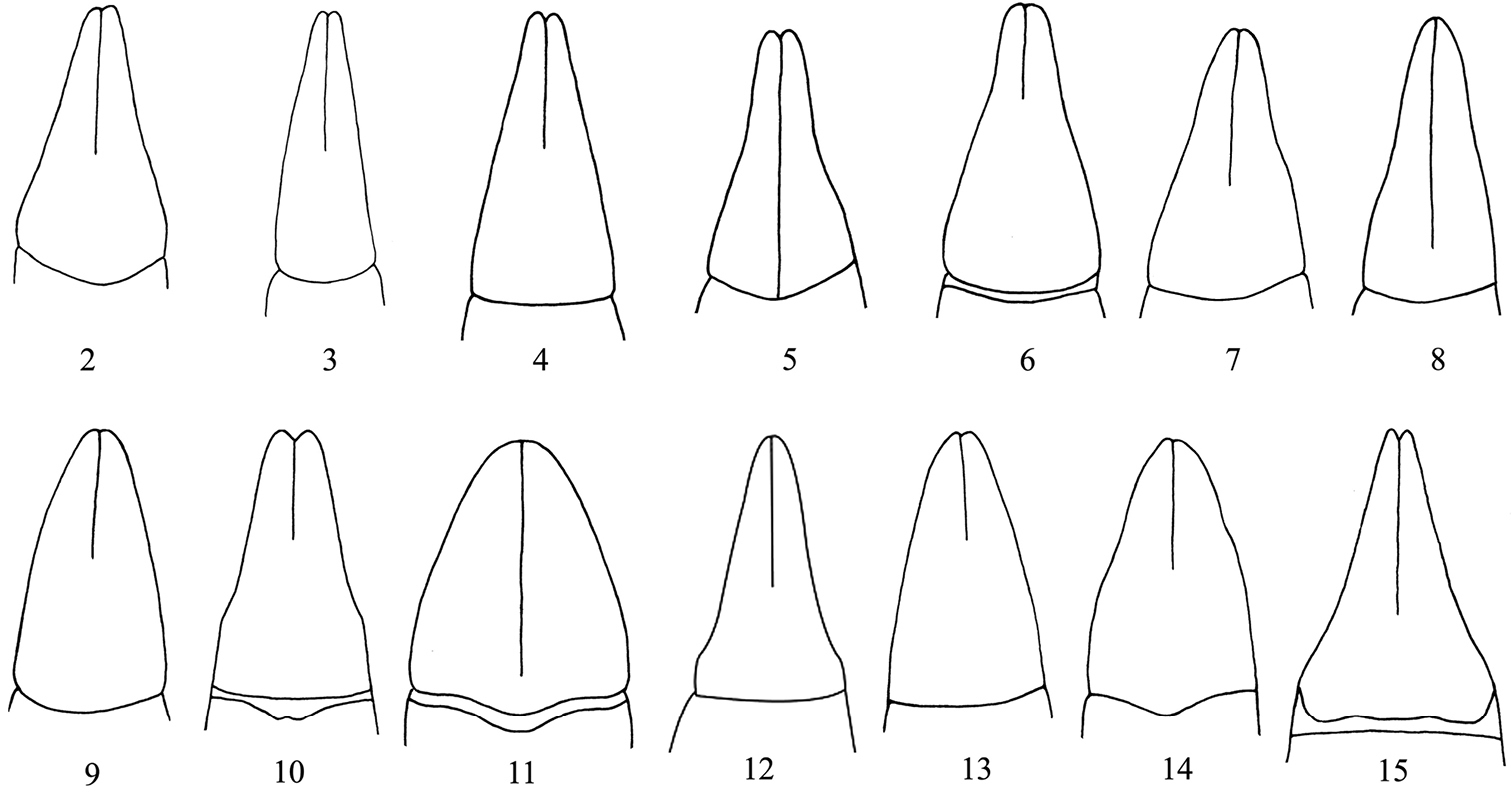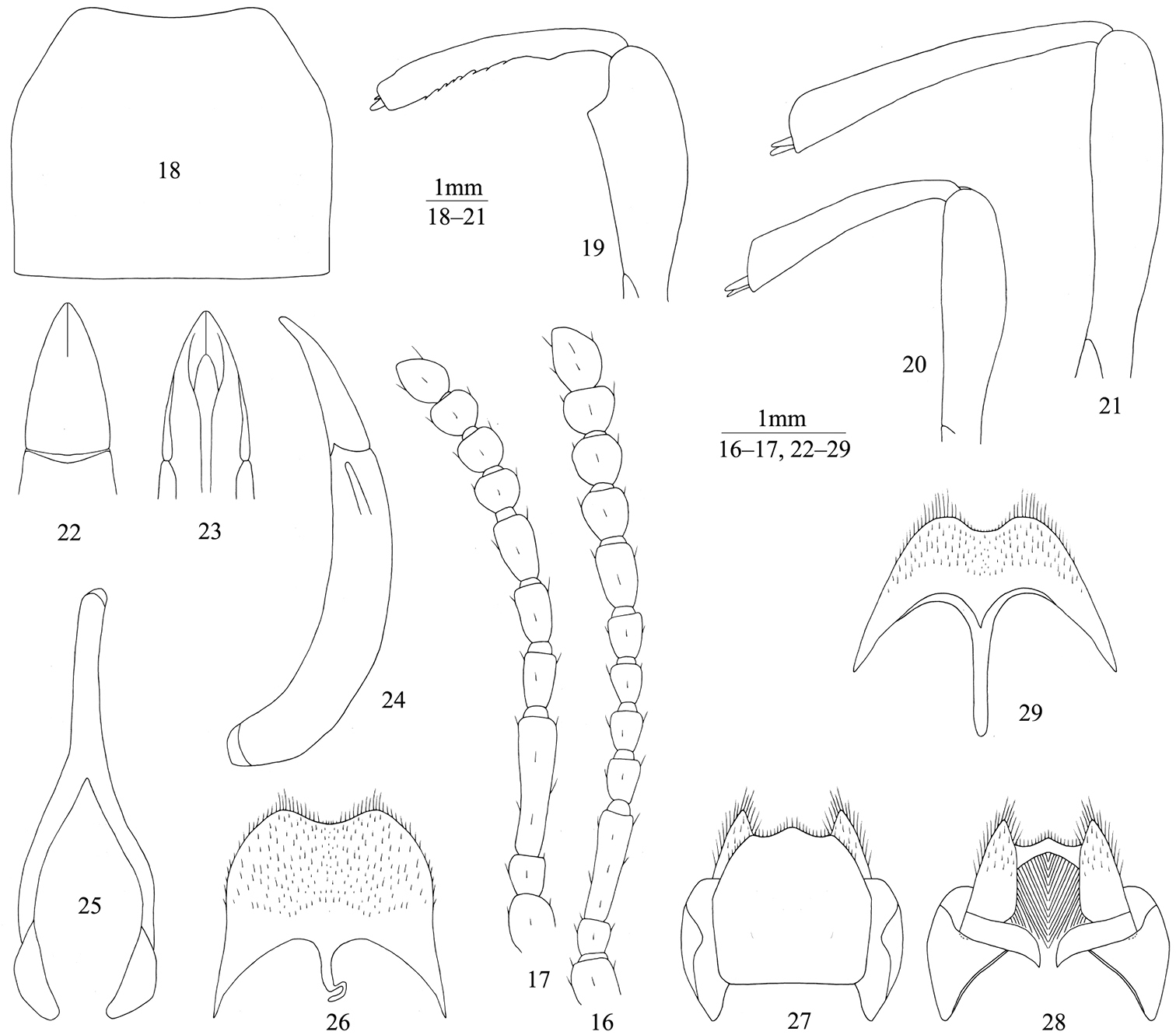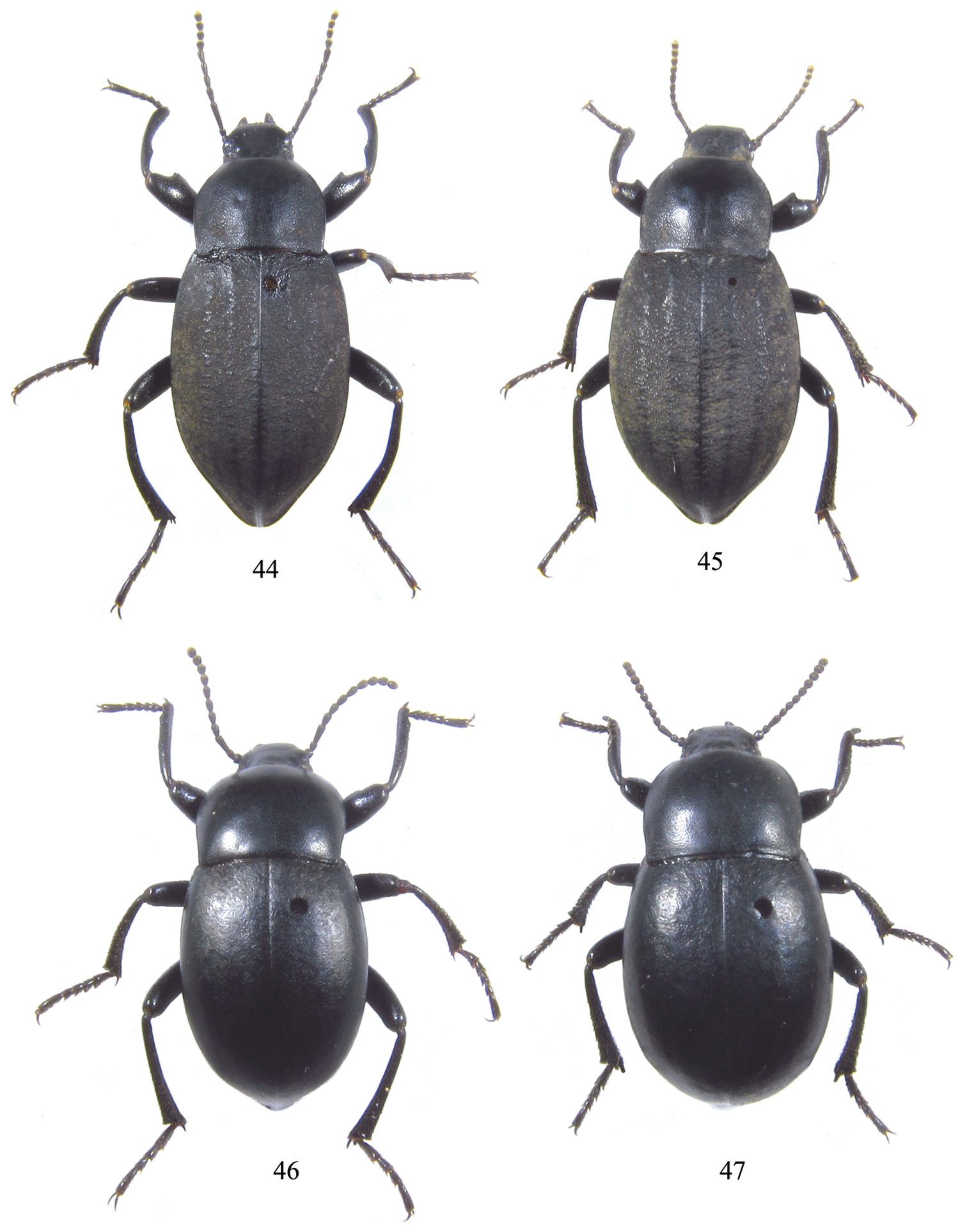






(C) 2013 Ai-min Shi. This is an open access article distributed under the terms of the Creative Commons Attribution License 3.0 (CC-BY), which permits unrestricted use, distribution, and reproduction in any medium, provided the original author and source are credited.
For reference, use of the paginated PDF or printed version of this article is recommended.
Two new species of Itagonia Reitter, 1887, Itagonia tibialis sp. n. and Itagonia litangensis sp. n. are described from Sichuan, China. A key to the known species of Itagonia from China is given.
Coleoptera, Tenebrionidae, Itagonia, new species, identification key, Sichuan, China
Itagonia Reitter, 1887 is among the most speciose genera in the subtribe Gnaptorinina of the tribe Blaptini. It comprises 19 species and one subspecies (
Distribution of species of the genus Itagonia Reitter from China: 1 Itagonia baxoica Liu & Ren, 2009 2 Itagonia bisetosa Medvedev, 1998 3 Itagonia cordiformis Shi & Ren, 2007 4 Itagonia elegans Medvedev, 1998 5 Itagonia litangensis sp. n. 6 Itagonia longicornis Shi & Ren, 2007 7 Itagonia medvedevi Shi et al., 2010 8 Itagonia mera Medvedev, 1998 9 Itagonia provostii Fairmaire, 1888 10 Itagonia semenovi Reitter, 1889 11 Itagonia shamaevi Medvedev, 2004 12 Itagonia szetschwana Schuster, 1923 13 Itagonia tibialis sp. n. 14 Itagonia trisetosa Medvedev, 1998 15 Itagonia tuberculata Shi et al., 2010 16 Itagonia xinlongensis Shi et al., 2010 17 Itagonia zayica Shi & Ren, 2007
In this study, we follow the classification of
During the identification of tenebrionid specimens collected in Sichuan in 2012, two new species of the genus Itagonia, Itagonia tibialis sp. n. from Jinchuan and Itagonia litangensis sp. n. from Litang were found, which are described below.
All specimens were examined and measured under a Leica M205C stereomicroscope. Drawings of the new species were prepared under the same microscope equipped with a drawing tube. The photos were taken with a Canon PowerShot SX150IS digital camera. All specimens studied are deposited in the Museum of China West Normal University (MCWNU), Nanchong, China.
| 1 | Upper edge of inner surface of profemur (figs 1–5 in |
2 |
| – | Upper edge of inner surface of profemur with arcuate or obtuse-angled prominence (figs 6–10, 14, 27, 40 in |
8 |
| 2 | Outer margin of epipleura visible from above along or nearly along entire length | 3 |
| – | Outer margin of epipleura visible from above at most in anterior 1/2 and/or apex | 4 |
| 3 | Tooth of profemur obtuse. Lateral margins of pronotum distinctly bordered before base. Apicale of aedeagus (Fig. 2) less elongate, 1.83 times as long as wide, with outer margins slightly sinuate near middle | Itagonia szetschwana Schuster, 1923 |
| – | Tooth of profemur sharply acute-angled. Lateral margins of pronotum very finely, almost invisibly bordered. Apicale of aedeagus (Fig. 3) more elongate, 2.61 times as long as wide, with outer margins nearly straight | Itagonia semenowi Reitter, 1889 |
| 4 | Only apical part of outer margin of epipleura visible from above | Itagonia shamaevi Medvedev, 2004 |
| – | At least part of anterior 1/2 of outer margin of epipleura visible from above | 5 |
| 5 | Each elytron with traces of two longitudinal carinae, dense granules and sparse irregular prominences. Inner surface of male protibiae with arcuate prominence near base | Itagonia tibialis sp. n. |
| – | Elytra with punctures and wrinkles. Inner surface of male protibiae straight near base | 6 |
| 6 | Pronotum more transverse, 1.40 times as wide as long, widest behind middle. Only plantar surface of protarsomere 1 with hair brush. Apicale of aedeagus (Fig. 4) with outer margins nearly straight | Itagonia provostii (Fairmaire, 1888) |
| – | Pronotum less transverse, 1.15–1.24 times as wide as long, widest in middle. Plantar surface of protarsomeres 1 and 2 and mesotarsomere 1 with hair brushes. Apicale of aedeagus (Figs 5, 6) with outer margins sinuate | 7 |
| 7 | Lateral margins of pronotum converging to base with almost straight line in basal half. Prosternum in front of procoxae oblique to horizontal plane. Metatibiae straight. Apicale of aedeagus (Fig. 5) with outer margins more sinuate near middle | Itagonia zayica Shi & Ren, 2007 |
| – | Lateral margins of pronotum almost parallel in basal half. Prosternum in front of procoxae almost vertical. Metatibiae weakly incurved. Apicale of aedeagus (Fig. 6) with outer margins less sinuate in apical 1/3 | Itagonia baxoica Liu & Ren, 2009 |
| 8 | Outer margin of epipleura visible from above along entire length | 9 |
| – | Outer margin of epipleura only partly visible from above | 12 |
| 9 | Lateral margins of pronotum distinctly reflexed. Plantar surface of pro- and mesotarsomeres without hair brush or only plantar surface of protarsomere 1 with small hair brush. Apicale of aedeagus (Fig. 7) with outer margins weakly sinuate before middle | Itagonia elegans Medvedev, 1998 |
| – | Lateral margins of pronotum not reflexed. At least plantar surface of protarsomeres 1 and 2 with hair brushes. Apicale of aedeagus with outer margins weakly sinuate near middle (Fig. 8), smoothly converging from base to apex (Fig. 9) or sinuate in basal 1/3 (Fig. 10) | 10 |
| 10 | Antennae longer, surpassing beyond pronotal base. Upper spur of protibiae slightly longer than the lower spur | Itagonia longicornis Shi & Ren, 2007 |
| – | Antennae shorter, not reaching or reaching, but not surpassing pronotal base. Upper spur of protibiae significantly longer than the lower spur | 11 |
| 11 | Anterior margin of pronotum more sinuate, lateral margins rectilinearly converging toward base in basal 1/2. Upper edge of inner surface of profemur with massive arcuate prominence near apex. Plantar surface of mesotarsomere 1 with apical tuft of light setae. Apicale of aedeagus (Fig. 9) with outer margins smoothly converging from base to apex | Itagonia bisetosa Medvedev, 1998 |
| – | Anterior margin of pronotum less sinuate, lateral margins slightly sinuate in basal 1/4. Upper edge of inner surface of profemur with obtuse-angled prominence near apex. Plantar surface of mesotarsomere 1 with small hair brush. Apicale of aedeagus (Fig. 10) with outer margins sinuate in basal 1/3, and apical part regularly narrowing towards apex | Itagonia xinlongensis Shi et al., 2010 |
| 12 | Plantar surface of protarsomeres 1 and 2 with hair brushes or apical tuft of pale hairs | 13 |
| – | Plantar surface of protarsomeres 1 to 3 with hair brushes | 14 |
| 13 | Pronotum widest before base, lateral margins less arcuately protruding. Elytral surface coarse, with irregular prominences and very sparse punctures. Plantar surface of mesotarsomere 1 with hair brush. Apicale of aedeagus (Fig. 11) less elongate, 1.46 times as long as wide, with outer margins smoothly converging from base to apex | Itagonia tuberculata Shi et al., 2010 |
| – | Pronotum widest before middle, lateral margins more arcuately protruding. Elytral surface smooth, with fine punctures and irregular wrinkles. Plantar surface of mesotarsomere 1 with apical tuft of pale hairs. Apicale of aedeagus (Fig. 12) more elongate, 2.0 times as long as wide, with outer margins sinuate in basal 1/4 | Itagonia cordiformis Shi & Ren, 2007 |
| 14 | Anterior 2/3 or only apical part of outer margin of epipleura visible from above | 15 |
| – | Less than anterior 1/2 of outer margin of epipleura visible from above | 16 |
| 15 | Pronotal surface not flattened along outer margins. Outer margin of epipleura in dorsal view concealed by outer convexity of elytra only in apical 1/3. Apicale of aedeagus (Fig. 13) with outer margins smoothly converging from base to apex. Body significantly smaller, length 9.6 mm | Itagonia trisetosa Medvedev, 1998 |
| – | Pronotal surface widely flattened along outer margins in basal half. Outer margin of epipleura visible from above only in apex. Apicale of aedeagus (Fig. 14) with outer margins slightly sinuate in apical part. Body large, length 10.8–11.7 mm | Itagonia mera Medvedev, 1998 |
| 16 | Prosternum in front of procoxae oblique to horizontal plane. Apical part of outer margin of epipleura visible from above. Upper spur of protibiae massive, longer than protarsomere 1. Plantar surface of mesotarsomere without hair brush. Apicale of aedeagus (Fig. 15) 1.51 times as long as wide | Itagonia medvedevi Shi et al., 2010 |
| – | Prosternum in front of procoxae steeply sloping. Apical part of outer margin of epipleura invisible from above. Upper spur of protibiae not massive, shorter than protarsomere 1. Plantar surface of mesotarsomeres 1 to 2 with hair brushes. Apicale of aedeagus (Fig. 36) 1.43 times as long as wide | Itagonia litangensis sp. n. |
urn:lsid:zoobank.org:act:0A1C342C-D3B4-44D7-B98A-D96D08FC5720
http://species-id.net/wiki/Itagonia_tibialis
Figs 16–29, 44–45Holotype male: China, Sichuan, Jinchuan, 31°29'N, 102°05'E, 2647 m, 31 Jul. 2012, Y. C. Li and Y. P. Lai leg. (MCWNU). Paratypes: 9 males and 5 females, same data as the holotype (MCWNU).
This new species can be distinguished from other Itagonia species by the following differences: each elytron with traces of two longitudinal carinae; inner surface of male protibiae with arcuate prominence near base. Itagonia tibialis sp. n. belongs to the group including also Itagonia bisetosa Medvedev, 1998, Itagonia tuberculata Shi et al., 2010 and Itagonia trisetosa Medvedev, 1998. Representatives of this group differ from other Itagonia species in having apicale of aedeagus flat, smoothly tapering from base to apex, forming no sharp narrowing in apical part (Figs 9, 11, 13, 22). Occurring together with Itagonia bisetosa, Itagonia tuberculata and Itagonia trisetosa, the new species can be distinguished by upper edge of inner surface of profemur forming in apical part rectangular tooth. Also, the described species sharply differs from Itagonia bisetosa and Itagonia trisetosa in having less than anterior 1/2 of outer margin of epipleura visible from above, and from Itagonia tuberculata in having the pronotum widest before middle.
Named after the protibiae of male, inner surface of which has an arcuate prominence near base. This sharply differs from those of other species of Itagonia.
Body black, elytra dull, other parts of body weakly shining.
Male (Figs 16, 18–26). Anterior margin of clypeus weakly sinuate. Lateral margin of head almost without incision above antennal base. Genal margin parallel before eyes. Eyes not protruding beyond contour of head. Vertex slightly convex or flat, with moderately dense punctures. Frontoclypeal suture very shallow or invisible. Antennae (Fig. 16) reaching or nearly reaching pronotal base. Length (width) ratio of antennomeres 2 to 11 as follows: 18(17): 67(18): 25(16): 27(17): 31(18): 31(18): 23(22): 22(24): 21(25): 31(23).
Pronotum (Fig. 18) 1.15–1.24 (1.19 on average, n=10) times as wide as long, maximum width before middle, 1.63–1.77 (1.68 on average, n=10) times as wide as head. Ratio of pronotal width at anterior margin to its maximum width and width at base (n=10) 0.55: 1.00: 0.94 on average. Lateral margins of pronotum sharply arcuately converging to anterior margin in anterior 1/3, slightly narrowing to base in basal half or nearly parallel in basal 1/4, entirely bordered. Anterior margin of pronotum weakly sinuate, bordered laterally; base straight, not bordered. Anterior angles of pronotum weakly obtuse, rounded apically; posterior ones weakly obtuse or nearly rectangular. Pronotal surface between lateral margins weakly convex, with shallow median depression at disc; punctures as large as those on head, fine at disc center and larger laterally. Propleura concave in basal half, with wrinkles and very sparse granules. Prosternum in front of procoxae gently sloping; intercoxal process with shallow median depression, steeply sloping behind procoxae.
Elytra elongate-oval, 1.56–1.65 (1.60 on average, n=10) times as long as wide, maximum width in anterior 1/3, 1.35–1.44 (1.41 on average, n=10) times as wide as pronotum. Less than anterior 1/2 of outer margin of epipleura visible from above. Elytral surface between epipleura and sutural margin convex. Each elytron with traces of 2 longitudinal carinae, dense granules and sparse irregular prominences. Epipleural surface smooth, with sparse wrinkles and very sparse granules. Abdominal ventrites with punctures and short brown setae, abdominal ventrites 1 to 3 with longitudinal wrinkles, basal two abdominal ventrites with concave impression in middle.
Legs (Figs 19–21) moderately robust, length (width) ratio of pro-, meso- and metafemora 74(26): 74(19): 100(21); tibiae: 70(11): 63(13): 95(14). Upper edge of inner surface of profemur with rectangular tooth in apical part. Inner surface of protibiae with arcuate prominence near base. Upper spur of protibiae not very massive, shorter than protarsomere 1, lower spur fine and pointed. Plantar surface of protarsomeres 1 and 2 and mesotarsomere 1 with hair brushes. Metatibiae weakly incurved, regularly widening apicad. Length (width) ratio of metatarsomeres 1 to 4 as follows: 25(6.4): 12(6.0): 12(5.7): 22(6.4).
Aedeagus (Figs 22–24): length 3.83 mm, width 0.79 mm. Apicale 1.33 mm long and 0.70 mm wide, with outer margins arcuately narrowing to apex. Spiculum gastrale as in Fig. 25. Apical margin of abdominal ventrite 8 sinuate (Fig. 26).
Female (Figs 17, 27–29). Body wider. Antennae (Fig. 17) shorter than in male. Pronotum 1.24–1.33 (1.28 on average, n=5) times as wide as long. Elytra 1.41–1.48 (1.44 on average, n=5) times as long as wide. Less than anterior 1/3 of outer margin of epipleura visible from above. Protibiae nearly straight. Upper spur of protibiae massive and rounded apically; lower spur fine. Metatibiae straight. Plantar surface of protarsomeres and mesotarsomeres without brush. Ovipositor as in Figs 27–28. Spiculum ventrale as in Fig. 29.
Male body length 13.4–15.1 mm, width 5.4–6.3 mm; female body length 13.8–15.6 mm, width 6.7–7.2 mm.
Apicale of aedeagus in dorsal view. 2 Itagonia szetschwana Schuster, 1923 3 Itagonia semenowi Reitter, 1889 4 Itagonia provostii (Fairmaire, 1888) 5 Itagonia zayica Shi & Ren, 2007 6 Itagonia baxoica Liu & Ren, 2009 7 Itagonia elegans Medvedev, 1998 8 Itagonia longicornis Shi & Ren, 2007 9 Itagonia bisetosa Medvedev, 1998 10 Itagonia xinlongensis Shi et al., 2010 11 Itagonia tuberculata Shi et al., 2010 12 Itagonia cordiformis Shi & Ren, 2007 13 Itagonia trisetosa Medvedev, 1998 14 Itagonia mera Medvedev, 1998 15 Itagonia medvedevi Shi et al., 2010. (figs 2–3 from
Itagonia tibialis sp. n. 16 antenna of male 17 antenna of female 18 pronotum of male 19 profemur and protibiae of male 20 mesofemur and mesotibiae of male 21 mtafemur and metatibiae of male 22–23 apicale of aedeagus in dorsal and ventral views 24 aedeagus in lateral view 25 spiculum gastrale 26 abdominal ventrite 8 of male 27–28 ovipositor in dorsal and ventral views 29 spiculum ventrale.
urn:lsid:zoobank.org:act:6964C433-F497-425E-A637-4D06DD365417
http://species-id.net/wiki/Itagonia_litangensis
Figs 30–43, 46–47Holotype male: China, Sichuan, Litang, 30°18'N, 100°16'E, 3410 m, 2 Aug. 2012, A. M. Shi leg. (MCWNU). Paratypes: 5 males and 4 females, same data as the holotype (MCWNU).
The new species resembles Itagonia medvedevi Shi et al., 2010 and Itagonia cordiformis Shi & Ren, 2007 by less than anterior 1/2 of outer margin of epipleura visible from above and apicale of aedeagus with outer margins sinuate, apical part rather sharply narrowing apicad (Figs 12, 15, 36). Itagonia litangensis sp. n. differs from Itagonia medvedevi and Itagonia cordiformis in having the prosternum in front of procoxae steeply sloping; upper spur of protibiae not massive, shorter than protarsomere 1; plantar surface of mesotarsomeres 1 to 2 with hair brushes; apical margin of abdominal sternite 8 weakly sinuate. Also, the new species can be distinguished from Itagonia medvedevi by apical part of outer margin of epipleura invisible from above, and from Itagonia cordiformis by lateral margins of pronotum weakly arcuately protruding.
Named after the type locality, Litang.
Body black, weakly shining.
Male (Figs 30, 32–40). Anterior margin of clypeus nearly straight. Lateral margin of head with obtuse-angled shallow incision above antennal base. Genal margin arcuately converging to clypeal base. Eyes not protruding beyond contour of head. Vertex slightly convex, with moderately dense punctures. Frontoclypeal suture shallow. Antennae (Fig. 30) reaching posterior 1/4 of pronotum. Length (width) ratio of antennomeres 2 to 11 as follows: 16(13): 33(14): 18(14): 18(14): 18(14): 20(14): 18(17): 18(19): 18(20): 25(19).
Pronotum (Fig. 32) transverse, 1.25–1.35 (1.28 on average, n=6) times as wide as long, maximum width before middle, 1.77–1.86 (1.84 on average, n=6) times as wide as head. Ratio of pronotal width at anterior margin to its maximum width and width at base (n=6) 0.67: 1.00: 0.91 on average. Lateral margins of pronotum more sharply arcuately narrowing to anterior margin than to base, entirely bordered. Anterior margin of pronotum nearly straight; base straight, both bordered laterally. Anterior angles of pronotum obtuse, rounded apically; posterior ones weakly obtuse. Pronotal surface between lateral margins convex, with short median depression at disc; punctures as large as those on head, fine at disc center and larger laterally. Propleura slightly concave, with wrinkles and very sparse granules. Prosternum in front of procoxae steeply sloping; intercoxal process with shallow median depression, steeply sloping behind procoxae.
Elytra elongate-oval, 1.35–1.42 (1.39 on average, n=6) times as long as wide, maximum width before middle, 1.21–1.31 (1.25 on average, n=6) times as wide as pronotum. Less than anterior 1/2 of outer margin of epipleura visible from above. Elytral surface between outer margin of epipleura and sutural margin convex, sparsely covered with irregular fine wrinkles and fine punctures. Epipleural surface with sparse wrinkles. Abdominal ventrites with punctures and brown setae, abdominal ventrites 1 to 3 with longitudinal wrinkles.
Legs (Figs 33–35) robust, length (width) ratio of pro-, meso- and metafemora 78(22): 82(20): 100(21); tibiae: 74(11): 71(12): 94(16). Upper spur of protibiae not massive, shorter than protarsomere 1, lower spur fine and pointed. Plantar surface of protarsomeres 1 to 3 and mesotarsomeres 1 to 2 with hair brushes. Metatibiae weakly incurved. Length (width) ratio of metatarsomeres 1 to 4 as follows: 24(8.0): 13(7.5): 12(6.7): 25(6.7).
Aedeagus (Figs 36–38): length 2.24 mm, width 0.71 mm. Apicale 0.69 mm long and 0.48 mm wide, with outer margins slightly sinuate in basal 1/3. Spiculum gastrale as in Fig. 39. Apical margin of abdominal ventrite 8 weakly sinuate (Fig. 40).
Female (Figs 31, 41–43). Body wider. Antennae (Fig. 31) shorter than in male. Pronotum 1.27–1.35 (1.32 on average, n=4) times as wide as long. Elytra 1.27–1.35 (1.31 on average, n=4) times as long as wide. Less than anterior 1/3 of outer margin of epipleura visible from above. Upper spur of protibiae massive and rounded apically; lower spur missing. Plantar surface of protarsomeres and mesotarsomeres without brush. Ovipositor as in Figs 41–42. Spiculum ventrale as in Fig. 43.
Male body length 11.0–12.2 mm, width 5.2–5.8 mm; female body length 11.4–12.1 mm, width 5.6–6.1 mm.
Itagonia litangensis sp. n. 30 antenna of male 31 antenna of female 32 pronotum of male 33 profemur and protibiae of male 34 mesofemur and mesotibiae of male 35 mtafemur and metatibiae of male 36–37 apicale of aedeagus in dorsal and ventral views 38 aedeagus in lateral view 39 spiculum gastrale 40 abdominal ventrite 8 of male 41–42 ovipositor in dorsal and ventral views 43 spiculum ventrale.
44–45 Itagonia tibialis sp. n. 44 male, length 14.2 mm 45 female, length 14.9 mm 46–47 Itagonia litangensis sp. n. 46 male, length 11.5 mm 47 female, length 11.8 mm.
I’m grateful to Yun-chun Li (China West Normal University) and Yong-ping Lai (China West Normal University) for their collaboration on the field trip. I think Wolfgang Schawaller and Otto Merkl for their comments which helped to improve my manuscript. This study is supported by the Key Research Project of the Sichuan Province Education Department of China (10ZA023) and Sichuan Key Provincial Discipline (SZD0420).




